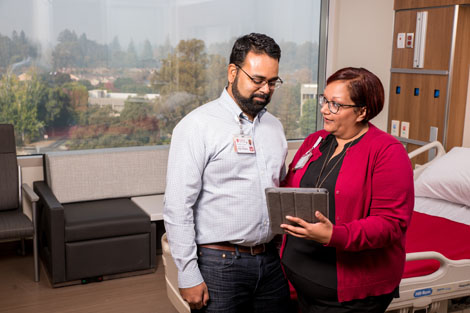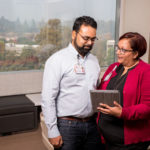The Connected Patient: Digital Tools Enhance the Patient Experience
By Alpa Vyas, Vice President, Patient Experience, Stanford Health Care
Few things in life are more stressful than the illness, injury or hospitalization of yourself or a loved one. So when designing how patients and families would experience the new Stanford Hospital, we tasked ourselves with creating an environment that would help alleviate that stress.
Our challenge was to create a digitally driven patient experience that matches the majestic façade of the new structure. From the private patient rooms to the four acres of outdoor gardens and green space to the expansive lobby, fountains and 400 pieces of original art, the physical environment of the new Stanford Hospital is absolutely stunning. The service and the culture we create inside must complement and enhance this physical environment.
From the moment patients and family members come through the doors of the new Stanford Hospital, a compassionate team of caregivers and staff will shepherd them through their health care journey. But digital tools developed specifically for the new space will also assist them. We are using smartphone technology that people already use in their daily lives to help guide patients, families and caregivers through their experience.
‘Digital companion’
Stanford’s MyHealth app will act as the digital companion for patients at the new Stanford Hospital. Navigating a large medical campus can be confusing. It’s especially difficult for patients who are already consumed by anxiety or worry about their health or the health of a loved one. The way-finding capability within MyHealth is one way of quelling that stress and improving the experience.
Patients can also use MyHealth to check-in for appointments and procedures and speed up the admitting process before their scheduled surgery or inpatient stay. The app automatically sends appointment reminders and step-by-step directions to locations within the building, guiding patients from the parking garage to the laboratory to the infusion treatment area and back again. All of these digital touch points were created to help make the experience seamless, hassle free and calming.
Privacy and comfort
Our patient rooms are another place we’ve embedded digital technology to enhance the patient experience. All of our 368 rooms are private, and each is equipped with a 55-inch television, an iPad and a remote at the bedside. We understand that people feel very vulnerable as patients in a hospital bed. When designing the patient rooms, we looked at some of the small things we can put back into the hands of our patients to give them a sense of control over their environment.
Using an intuitive keypad, patients can select movies, on-demand TV, music, relaxation videos, white noise, spiritual content and patient education information; they can also stream personal content using a screencast feature built into the entertainment system. Initially developed for the hospitality industry, the entertainment system will be closer to what patients have at home with an easy to navigate user interface. Patients will also be able to control their room’s temperature, lighting and window blinds, all without getting out of bed.
The new hospital’s rooms have been built with ample space for family members and visitors, including a foldout couch for overnight stays. The in-room visitor area includes extra plug-ins for electronic devices and storage for personal belongings, two seemingly small features that patients and families told us were essential.
A more connected care team
New digital tools are also giving our staff more time to do what they do best—caring for our patients. Our doctors, nurses, therapists, case workers and support staff must work together to coordinate medical services and manage a patient’s return to health. Improving this team’s ability to communicate and collaborate easily, in a way that protects patient privacy, was a priority as we move into the larger space of the new hospital.
Stanford has implemented a new, secure messaging platform that allows providers to communicate via phone call or text about a patient’s personal health information in a protected environment. That means more time for patient care, and less time searching for team members when a question arises. On an average day, 3,700 providers use the new platform to send 30,000 text messages and make 6,000 calls. It is a faster, more efficient way for our physicians, nurses and ancillary staff to collaborate on patient care.
As we anxiously await the opening of the new Stanford Hospital later this fall, we continue to fine-tune the patient experience, bringing on proven technologies from other facets of our lives to enhance how we care for our patients and families. While we understand that a trip to a medical campus is oftentimes an unexpected and stressful event, we believe we have created a place where patients, families and visitors will feel pampered, cared for and guided every step of the way.





